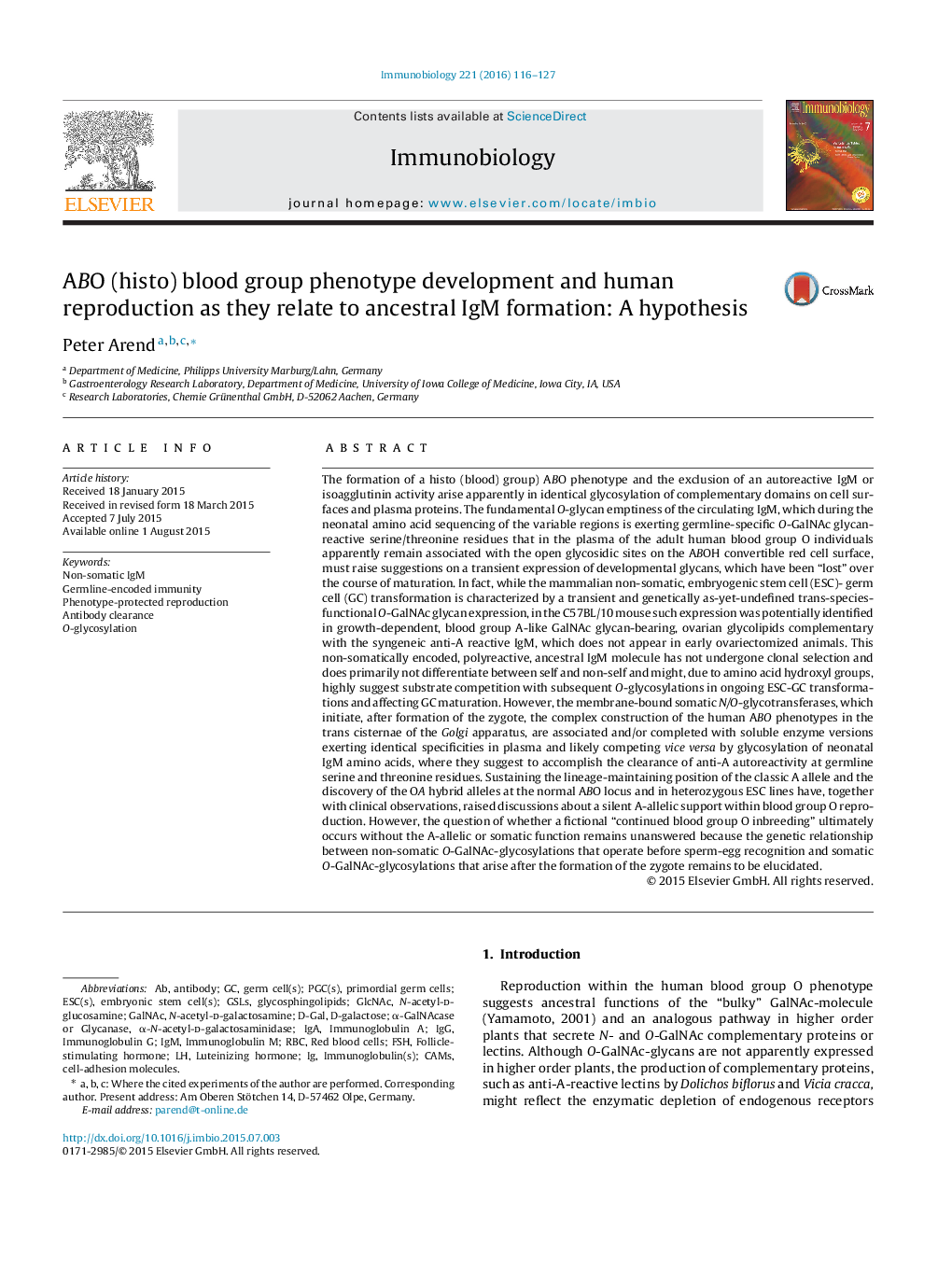| کد مقاله | کد نشریه | سال انتشار | مقاله انگلیسی | نسخه تمام متن |
|---|---|---|---|---|
| 10940803 | 1095512 | 2016 | 12 صفحه PDF | دانلود رایگان |
عنوان انگلیسی مقاله ISI
ABO (histo) blood group phenotype development and human reproduction as they relate to ancestral IgM formation: A hypothesis
دانلود مقاله + سفارش ترجمه
دانلود مقاله ISI انگلیسی
رایگان برای ایرانیان
کلمات کلیدی
IgGGlcNAcIgMO-GlycosylationGSLSGalNAcN-acetyl-d-glucosamineRBCRed blood cells - سلولهای قرمز خونCAMs - CAM هاD-galactose - D-گالاکتوزN-Acetyl-D-Galactosamine - N-استیل D-گالاکتوزامینimmunoglobulin(s) - ایمونوگلوبولین (ها)immunoglobulin A - ایمونوگلوبولین Aimmunoglobulin G - ایمونوگلوبولین GIgA - ایمونوگلوبولین IgA immunoglobulin M - ایمونوگلوبولین Md-gal - د-گالprimordial germ cells - سلول های بنیادی اولیهCell-adhesion molecules - مولکول های چسبندگی سلولیfollicle-stimulating hormone - هورمون تحریک کننده فولیکولluteinizing hormone - هورمون جسم زردFSH - هورمون محرکه فولیکولی Antibody - پادتَن یا آنتیبادیGlycosphingolipids - گلیسفینگولایپید ها
موضوعات مرتبط
علوم زیستی و بیوفناوری
بیوشیمی، ژنتیک و زیست شناسی مولکولی
بیولوژی سلول
پیش نمایش صفحه اول مقاله

چکیده انگلیسی
The formation of a histo (blood) group) ABO phenotype and the exclusion of an autoreactive IgM or isoagglutinin activity arise apparently in identical glycosylation of complementary domains on cell surfaces and plasma proteins. The fundamental O-glycan emptiness of the circulating IgM, which during the neonatal amino acid sequencing of the variable regions is exerting germline-specific O-GalNAc glycan-reactive serine/threonine residues that in the plasma of the adult human blood group O individuals apparently remain associated with the open glycosidic sites on the ABOH convertible red cell surface, must raise suggestions on a transient expression of developmental glycans, which have been “lost” over the course of maturation. In fact, while the mammalian non-somatic, embryogenic stem cell (ESC)- germ cell (GC) transformation is characterized by a transient and genetically as-yet-undefined trans-species-functional O-GalNAc glycan expression, in the C57BL/10 mouse such expression was potentially identified in growth-dependent, blood group A-like GalNAc glycan-bearing, ovarian glycolipids complementary with the syngeneic anti-A reactive IgM, which does not appear in early ovariectomized animals. This non-somatically encoded, polyreactive, ancestral IgM molecule has not undergone clonal selection and does primarily not differentiate between self and non-self and might, due to amino acid hydroxyl groups, highly suggest substrate competition with subsequent O-glycosylations in ongoing ESC-GC transformations and affecting GC maturation. However, the membrane-bound somatic N/O-glycotransferases, which initiate, after formation of the zygote, the complex construction of the human ABO phenotypes in the trans cisternae of the Golgi apparatus, are associated and/or completed with soluble enzyme versions exerting identical specificities in plasma and likely competing vice versa by glycosylation of neonatal IgM amino acids, where they suggest to accomplish the clearance of anti-A autoreactivity at germline serine and threonine residues. Sustaining the lineage-maintaining position of the classic A allele and the discovery of the OA hybrid alleles at the normal ABO locus and in heterozygous ESC lines have, together with clinical observations, raised discussions about a silent A-allelic support within blood group O reproduction. However, the question of whether a fictional “continued blood group O inbreeding” ultimately occurs without the A-allelic or somatic function remains unanswered because the genetic relationship between non-somatic O-GalNAc-glycosylations that operate before sperm-egg recognition and somatic O-GalNAc-glycosylations that arise after the formation of the zygote remains to be elucidated.
ناشر
Database: Elsevier - ScienceDirect (ساینس دایرکت)
Journal: Immunobiology - Volume 221, Issue 1, January 2016, Pages 116-127
Journal: Immunobiology - Volume 221, Issue 1, January 2016, Pages 116-127
نویسندگان
Peter Arend,